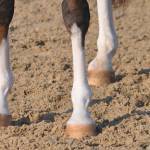Pain Control in Horses with Forelimb Lameness

Among the requirements of a riding or driving horse, soundness ranks high, as it is a valuable measure of comfort and well-being. When lameness occurs, especially chronic unsoundness, pain-relieving medication is often prescribed by veterinarians in an effort to alleviate discomfort. A recent study tested the efficacy of gabapentin in horses with chronic forelimb lameness.1
“In human medicine, the anticonvulsant gabapentin has been used to treat chronic pain syndromes, including neuropathic pain. Gabapentin is typically prescribed to ameliorate neuropathic pain that does not respond to nonsteroidal anti-inflammatory drugs (NSAIDs) or opiates,” said Catherine Whitehouse, M.S., a nutrition advisor with Kentucky Equine Research. “Specifically, gabapentin eases post-surgical pain in humans.”
Gabapentin has been used in horses for many years, and is often prescribed as adjunct therapy for horses with pain rising from laminitis, particularly as part of a multimodal approach to pain management.2
In the recent study, researchers used 14 horses with long-lasting forelimb lameness to evaluate the pain-relieving effects of oral gabapentin. Gabapentin was tested against a control and two other treatments: firocoxib (a popular NSAID) and a combination of firocoxib and gabapentin. Lameness was measured subjectively and biomechanically.
In the study, gabapentin was administered at a dosage of 20 mg/kg, which is considered safe in horses.3 At this dosage, gabapentin did not improve any measure of lameness in horses with chronic musculoskeletal pain in the thoracic limbs. In contrast, subjective examination identified an improvement in lameness with firocoxib and a combination of firocoxib and gabapentin. The researchers concluded that “higher oral dosing and longer treatment regimens of gabapentin may be indicated for the treatment of chronic musculoskeletal pain in horses.”
Owners of performance horses must take care in reaching for gabapentin for chronic problems, as several governing bodies of show horses and racehorses classify the drug as performance-enhancing.4,5
“Identifying the source of the pain should be the goal of a thorough lameness evaluation. Proper treatment and rest, in addition to analgesics, should be offered to the horse to maximize comfort and speed healing. A veterinarian that specializes in lameness is a tremendous asset when unsoundness persists,” Whitehouse said.
In treating lamenesses, veterinarians often prescribe NSAIDs. Antiulcer supplements should be given to horses that receive these medications, as some are known to cause gastric ulceration.
Keeping horses pain-free during long performance careers frequently takes preemptive care. “This can be achieved through the use of research-proven joint supplements made from high-quality ingredients. Proactive joint care begins before a performance horse has a problem,” she added.
1Young, J.M., M.J. Schoonover, S.L. Kembel, J.D. Taylor, A.G. Bauck, and L.L. Gilliam. 2019. Efficacy of orally administered gabapentin in horses with chronic thoracic limb lameness. Veterinary Anaesthesia and Analgesia Dec. 4.
2Guedes, A. 2013. How to provide pain relief for laminitis in the field. In: Proc. American Association of Equine Practitioners 59:467-468.
3Terry, R.L., S.M. McDonnell, A.W. Van Eps, L.R. Soma, et al. 2010. Pharmacokinetic profile and behavioral effects of gabapentin in the horse. Journal of Veterinary Pharmacology and Therapeutics 33:485-494.
4Association of Racing Commissioners International. 2019. Uniform Classification Guidelines for Foreign Substances and Recommended Penalties Model Rule.
5United Stated Equestrian Federation. 2019. USEF Guidelines and Rules for Drugs and Medications.








